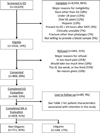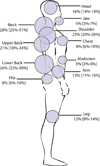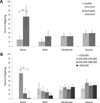Incidence and predictors of neck and widespread pain after motor vehicle collision among US litigants and nonlitigants
- PMID: 24145211
- PMCID: PMC3902045
- DOI: 10.1016/j.pain.2013.10.016
Incidence and predictors of neck and widespread pain after motor vehicle collision among US litigants and nonlitigants
Abstract
Debate continues regarding the influence of litigation on pain outcomes after motor vehicle collision (MVC). In this study we enrolled European Americans presenting to the emergency department (ED) in the hours after MVC (n=948). Six weeks later, participants were interviewed regarding pain symptoms and asked about their participation in MVC-related litigation. The incidence and predictors of neck pain and widespread pain 6weeks after MVC were compared among those engaged in litigation (litigants) and those not engaged in litigation (nonlitigants). Among the 859 of 948 (91%) participants completing 6-week follow-up, 711 of 849 (83%) were nonlitigants. Compared to nonlitigants, litigants were less educated and had more severe neck pain and overall pain, and a greater extent of pain at the time of ED evaluation. Among individuals not engaged in litigation, persistent pain 6weeks after MVC was common: 199 of 711 (28%) had moderate or severe neck pain, 92 of 711 (13%) had widespread pain, and 29 of 711 (4%) had fibromyalgia-like symptoms. Incidence of all 3 outcomes was significantly higher among litigants. Initial pain severity in the ED predicted pain outcomes among both litigants and nonlitigants. Markers of socioeconomic disadvantage predicted worse pain outcomes in litigants but not nonlitigants, and individual pain and psychological symptoms were less predictive of pain outcomes among those engaged in litigation. These data demonstrate that persistent pain after MVC is common among those not engaged in litigation, and provide evidence for bidirectional influences between pain outcomes and litigation after MVC.
Keywords: Jurisprudence; Legislation; Motor vehicle collision; Musculoskeletal pain; Neck pain; Whiplash injuries.
Copyright © 2013 International Association for the Study of Pain. Published by Elsevier B.V. All rights reserved.
Conflict of interest statement
Figures













Comment in
-
McLean et al.’s paper, ‘‘Incidence and predictors of neck and widespread pain after motor vehicle collision among U.S. litigants and nonlitigants’’.Pain. 2014 Jul;155(7):1416. doi: 10.1016/j.pain.2014.03.016. Epub 2014 Mar 28. Pain. 2014. PMID: 24680786 No abstract available.
-
Response to letter to the Editor.Pain. 2014 Jul;155(7):1416-1418. doi: 10.1016/j.pain.2014.04.014. Epub 2014 Apr 21. Pain. 2014. PMID: 24769188 No abstract available.
Similar articles
-
McLean et al.’s paper, ‘‘Incidence and predictors of neck and widespread pain after motor vehicle collision among U.S. litigants and nonlitigants’’.Pain. 2014 Jul;155(7):1416. doi: 10.1016/j.pain.2014.03.016. Epub 2014 Mar 28. Pain. 2014. PMID: 24680786 No abstract available.
-
Radiofrequency medial branch neurotomy in litigant and nonlitigant patients with cervical whiplash: a prospective study.Spine (Phila Pa 1976). 2001 Jun 15;26(12):E268-73. doi: 10.1097/00007632-200106150-00016. Spine (Phila Pa 1976). 2001. PMID: 11426167 Clinical Trial.
-
Persistent and Widespread Pain Among African-Americans Six Weeks after MVC: Emergency Department-based Cohort Study.West J Emerg Med. 2020 Dec 16;22(2):139-147. doi: 10.5811/westjem.2020.8.47450. West J Emerg Med. 2020. PMID: 33856293 Free PMC article.
-
Temporomandibular disorders, headaches, and neck pain following motor vehicle accidents and the effect of litigation: review of the literature.J Orofac Pain. 1996 Spring;10(2):101-25. J Orofac Pain. 1996. PMID: 9133856 Review.
-
Chronic whiplash syndrome as a functional disorder.Arch Neurol. 2000 Apr;57(4):592-4. doi: 10.1001/archneur.57.4.592. Arch Neurol. 2000. PMID: 10768638 Review. No abstract available.
Cited by
-
Duration of Reduction in Enduring Stress-Induced Hyperalgesia Via FKBP51 Inhibition Depends on Timing of Administration Relative to Traumatic Stress Exposure.J Pain. 2022 Jul;23(7):1256-1267. doi: 10.1016/j.jpain.2022.02.007. Epub 2022 Mar 14. J Pain. 2022. PMID: 35296422 Free PMC article.
-
Can the transverse foramen/vertebral artery ratio of double transverse foramen subjects be a risk for vertebrobasilar transient ischemic attacks?J Anat. 2018 Jun 7;233(3):341-6. doi: 10.1111/joa.12839. Online ahead of print. J Anat. 2018. PMID: 29882351 Free PMC article.
-
Pain Sensitivity Modifies Risk of Injury-Related Temporomandibular Disorder.J Dent Res. 2020 May;99(5):530-536. doi: 10.1177/0022034520913247. Epub 2020 Mar 20. J Dent Res. 2020. PMID: 32197057 Free PMC article.
-
Sex differences in the transition to chronic pain.J Clin Invest. 2025 Jun 2;135(11):e191931. doi: 10.1172/JCI191931. eCollection 2025 Jun 2. J Clin Invest. 2025. PMID: 40454485 Free PMC article. Review.
-
Incident injury is strongly associated with subsequent incident temporomandibular disorder: results from the OPPERA study.Pain. 2019 Jul;160(7):1551-1561. doi: 10.1097/j.pain.0000000000001554. Pain. 2019. PMID: 30883525 Free PMC article.
References
-
- Berglund A, Bodin L, Jensen I, Wiklund A, Alfredsson L. The influence of prognostic factors on neck pain intensity, disability, anxiety and depression over a 2-year period in subjects with acute whiplash injury. Pain. 2006;125(3):244–256. - PubMed
-
- Bjornstig U, Hildingsson C, Toolanen G. Soft-tissue injury of the neck in a hospital based material. Scand J Soc Med. 1990;18(4):263–267. - PubMed
-
- Borchgrevink GE, Lereim I, Royneland L, Bjorndal A, Haraldseth O. National health insurance consumption and chronic symptoms following mild neck sprain injuries in car collisions. Scandinavian Journal of Social Medicine. 1996;24(4):264–271. - PubMed
Publication types
MeSH terms
Grants and funding
LinkOut - more resources
Full Text Sources
Other Literature Sources
Medical

